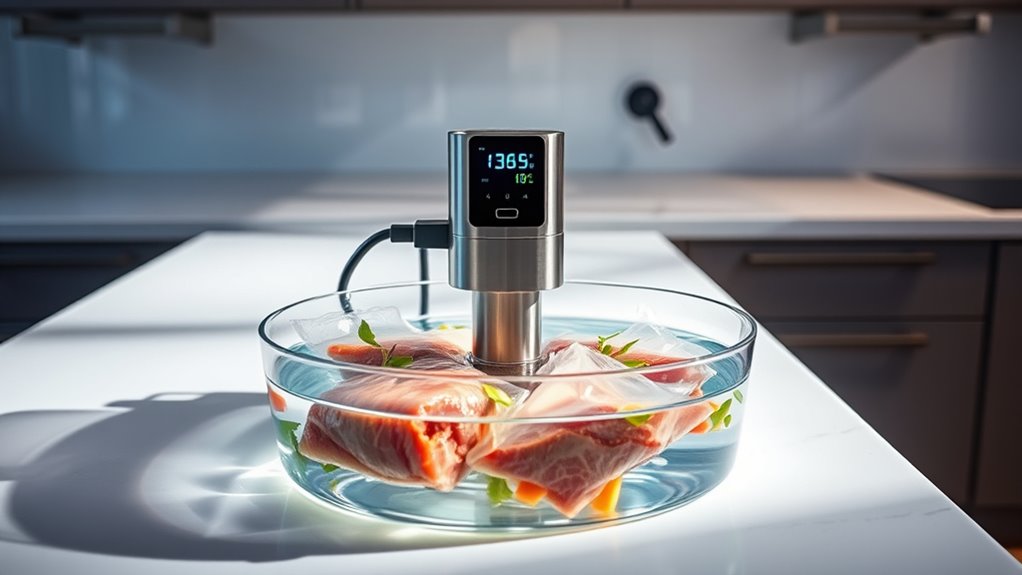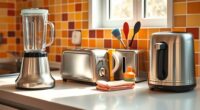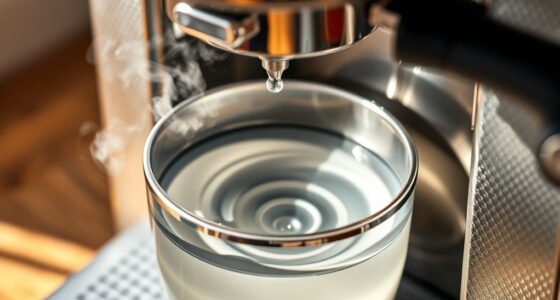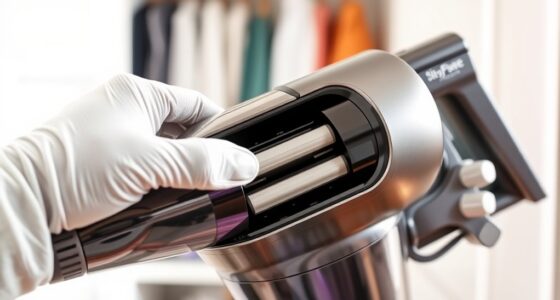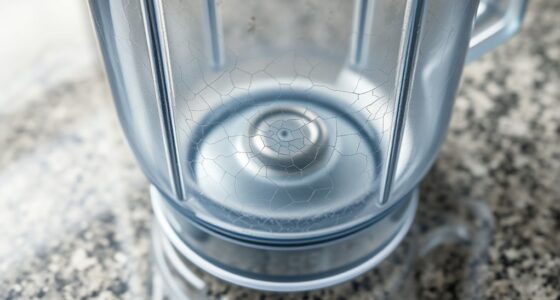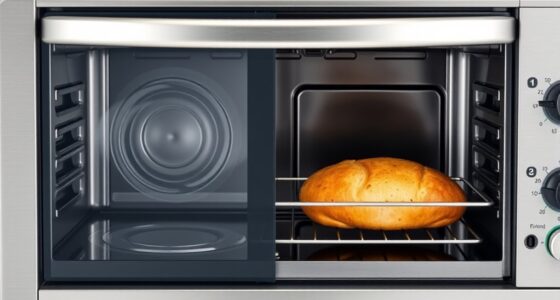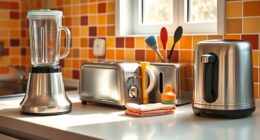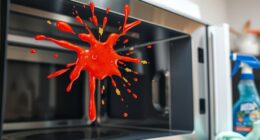To guarantee sous vide safety, it’s essential to control both temperature and time precisely. Holding foods at specific temperatures, like 135°F (57°C), for recommended durations—such as 1–2 hours—effectively kills harmful bacteria. Using a good immersion circulator and a reliable thermometer helps maintain accuracy. Properly sealed bags and sanitation practices also prevent contamination. Paying attention to these key factors ensures your food is safe and delicious—learn more about the details that make this process effective.
Key Takeaways
- Maintaining precise water temperatures with a reliable immersion circulator is crucial for effective pasteurization.
- Holding food at specific temperatures (e.g., 135°F for 1–2 hours) ensures bacteria like Salmonella are destroyed safely.
- Consistent timing and temperature control are essential; even small deviations can affect safety.
- Proper sealing, sanitation, and handling prevent contamination during and after sous vide cooking.
- Using a digital thermometer to verify water temperature helps ensure accurate pasteurization times.
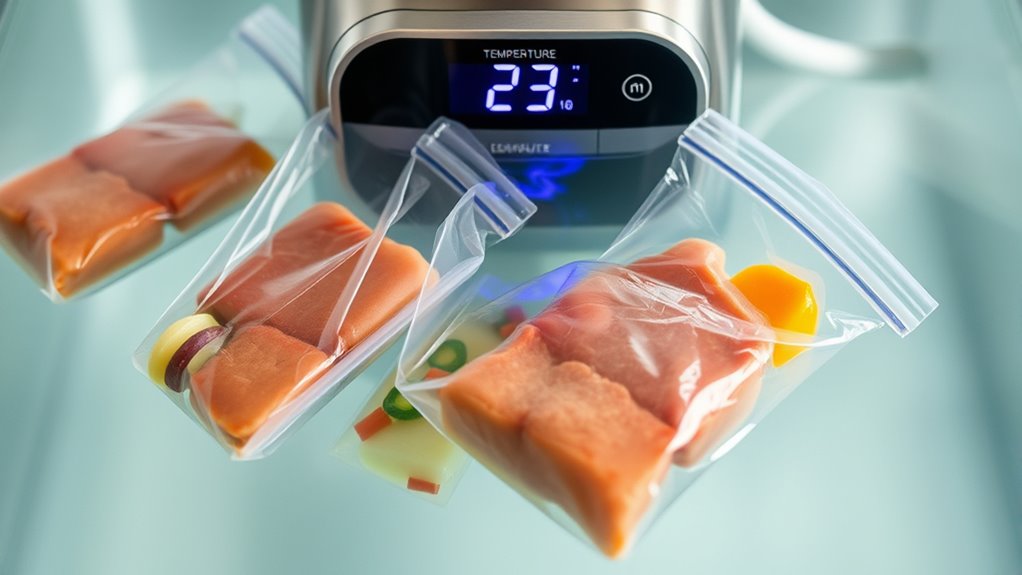
Sous vide cooking offers precise temperature control that can produce perfectly cooked meals, but it also requires careful attention to safety. When you’re using this method, maintaining the correct temperature is essential to guarantee harmful bacteria are eliminated. Temperature control isn’t just about achieving the perfect doneness; it’s about making sure your food is safe to eat. Bacterial elimination depends heavily on holding foods at specific temperatures for designated periods. If the temperature isn’t accurate or stable, bacteria like Salmonella and Listeria can survive and pose health risks.
Maintaining precise temperature control in sous vide is crucial for safety and bacterial elimination.
To keep your food safe, you need to understand the relationship between temperature and time. For example, cooking chicken to an internal temperature of 140°F (60°C) won’t automatically make it safe unless you hold it at that temperature long enough to destroy bacteria. Conversely, raising the temperature slightly can shorten the necessary cooking time. This interplay between temperature control and time is essential for effective pasteurization. If your water bath fluctuates or if the food isn’t heated evenly, some areas might not reach the necessary temperature, leaving bacteria alive. That’s why investing in a good immersion circulator with accurate, reliable temperature controls is indispensable.
It’s also important to follow recommended pasteurization times. For instance, holding foods at 135°F (57°C) for around 1 to 2 hours can considerably reduce bacteria, but it’s crucial to stick to established guidelines. These times are backed by scientific research and ensure you’re not just cooking your food but also making it safe to consume. Remember, the goal is bacterial elimination, which requires consistent temperature maintenance throughout the entire cooking process. Using a digital thermometer to verify water temperature can help you monitor and adjust as needed.
Additionally, sanitation before and after cooking plays a role in safety. Properly cleaning your equipment, sealing bags correctly, and avoiding cross-contamination are all part of a thorough safety approach. Even if your sous vide setup is perfect, neglecting these steps can introduce bacteria or other contaminants. Properly understanding pasteurization times and how they relate to temperature can help you optimize safety. Also, once cooking is complete, you should cool and refrigerate leftovers promptly to prevent bacterial growth.
Frequently Asked Questions
Can Sous Vide Cooking Kill All Bacteria Instantly?
No, sous vide cooking doesn’t kill all bacteria instantly. It effectively reduces harmful bacteria and bacterial spores when you cook at proper temperatures for specific times, but it doesn’t eliminate all spores or prevent toxin formation if the food isn’t handled correctly afterward. To guarantee safety, you need to follow recommended pasteurization times and temperatures closely, and avoid leaving cooked food at unsafe temperatures, which can allow bacteria to survive or produce toxins.
Is It Safe to Leave Sous Vide Food at Room Temperature?
Sure, leaving sous vide food at room temperature might seem tempting, but it’s a recipe for trouble. You should never do it because good food storage relies on strict temperature control. Bacteria thrive in the “danger zone” (40-140°F), and room temperature is right there. For safety, keep your food chilled or hot, and never leave it out to avoid risking foodborne illnesses.
How Do I Prevent Cross-Contamination During Sous Vide?
To prevent cross-contamination during sous vide, you should practice proper sanitation by thoroughly cleaning all utensils, containers, and your work area before starting. Always handle raw ingredients carefully, using separate cutting boards and tools, and wash your hands frequently. Seal ingredients properly to avoid leaks, and keep raw and cooked foods separate. These steps help guarantee food safety and prevent cross-contamination throughout your cooking process.
What Are the Risks of Under-Pasteurization?
If you under-pasteurize, you risk not achieving sufficient thermal destruction of harmful bacteria, which can lead to foodborne illnesses. Bacteria inactivation depends on proper temperature and time; missing these can allow pathogens to survive. Visualize bacteria as stubborn invaders that require adequate heat to be fully destroyed. Ignoring pasteurization times increases the danger, so make certain you follow recommended guidelines to effectively inactivate bacteria and keep your food safe.
Can Sous Vide Eliminate Parasites in Meat?
Yes, sous vide can eliminate parasites in meat when you use proper temperature and time. Parasite elimination is achieved through precise heat, ensuring harmful organisms like Trichinella or Toxoplasma are destroyed. To maximize meat safety, always follow recommended pasteurization times for specific temperatures. By doing so, you reduce health risks and enjoy safe, delicious meals. Remember, accurate temperature control is key to effective parasite elimination and overall food safety.
Conclusion
Now that you know the basics of sous vide pasteurization, you’re ready to cook safely and confidently. Think of it like a dance—once you learn the steps, you can glide through with ease. Remember, precision and patience are your best friends in sous vide cooking. By following the right times and temperatures, you’ll enjoy perfectly cooked, safe meals every time. So go ahead, master the technique and savor every delicious, worry-free bite.
